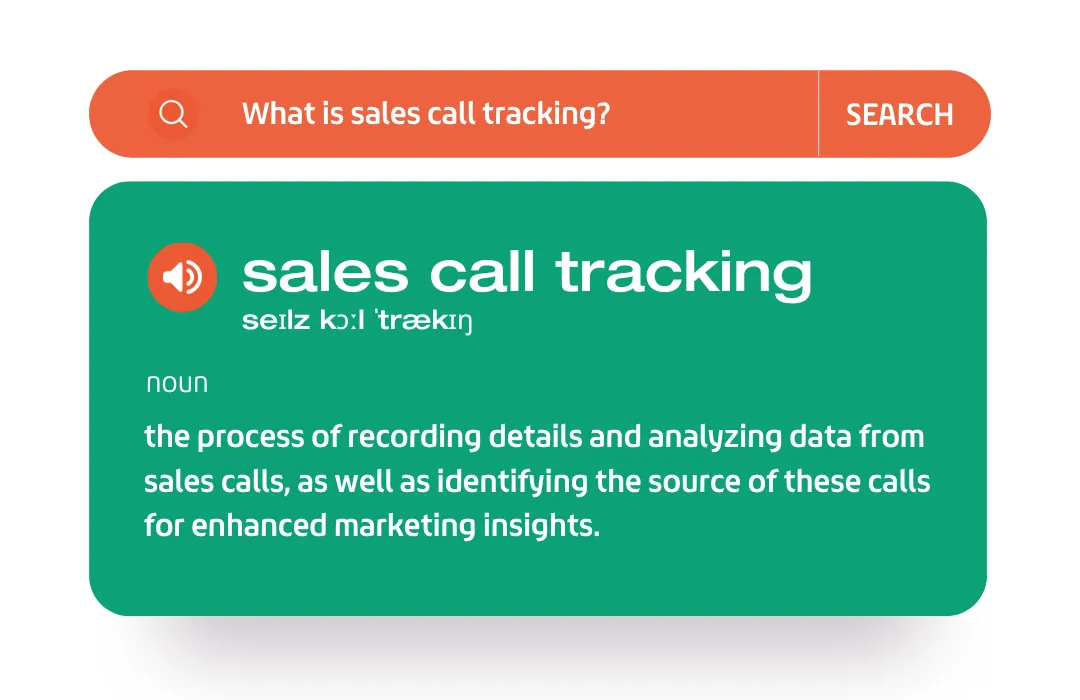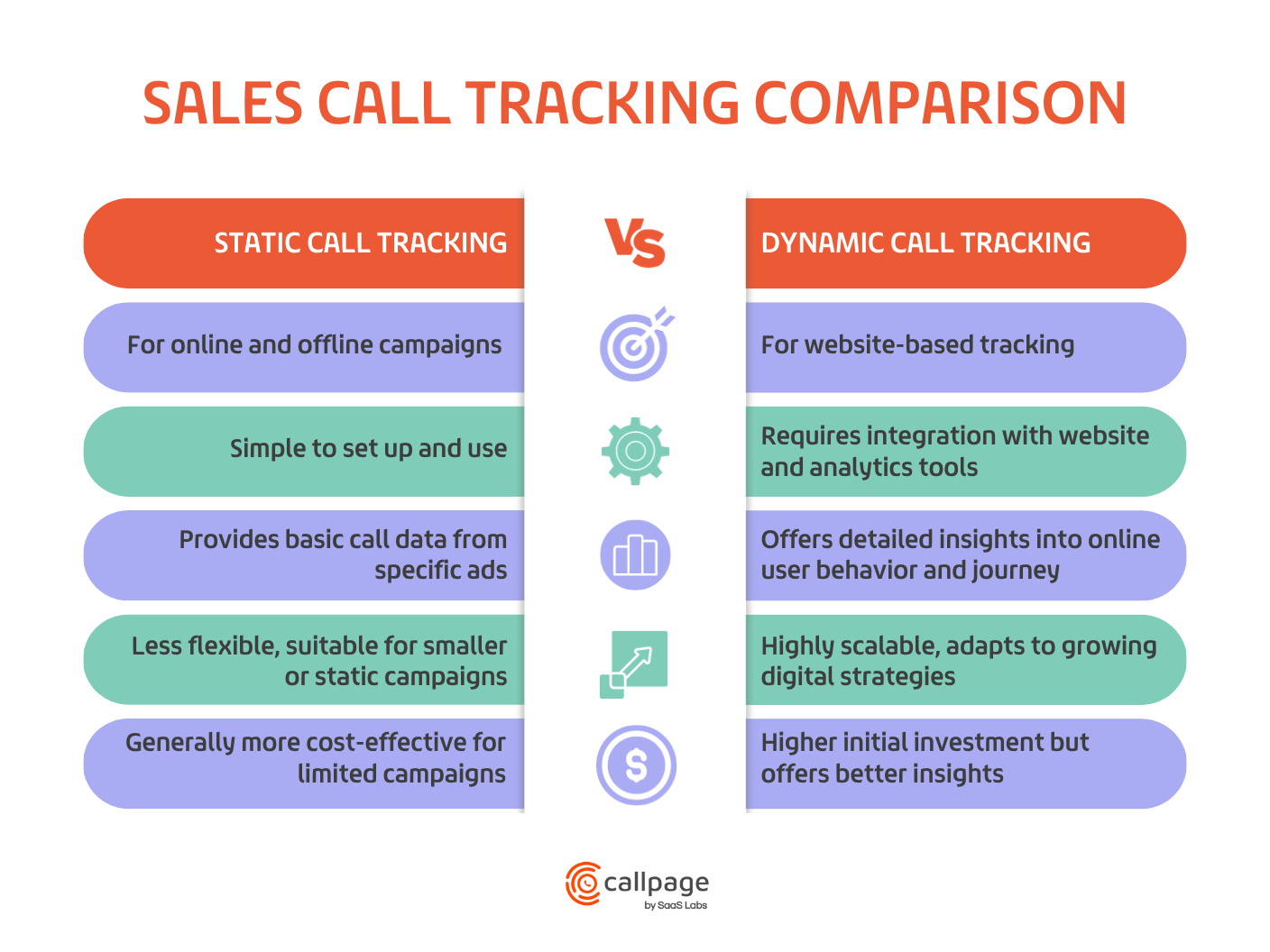
How to Track Sales Calls Effectively & Why You Need Sales Call Tracking Software
Check out our guide to sales call tracking to learn how you can make every call a step toward growing your business. Find out why it's important and how the right tools can help. Track sales calls like a pro!
Sales Call Tracking — Article Summary
- What Is Sales Call Tracking?
- Why Is Sales Call Tracking Important?
- How Can You Track Sales Calls?
- Why Is Tracking Call Sources Important?
- How Does Call Tracking Work with CallPage?
- How to Utilize Call Recording?
- Which Call Data and Metrics You Should Track
- Why It’s Important to Integrate With Other Tools
- How to Choose the Best Call Tracking Software?
In the bustling world of sales, every ring, beep, and dial tone can be the gateway to your next big deal. But how do you ensure that you're not just making calls but making them count? With the right sales call tracking software.
What Is Sales Call Tracking?
Sales call tracking is a method used by businesses to capture and analyze information related to incoming and outgoing phone calls. It is primarily used to measure the effectiveness of marketing campaigns and sales efforts, especially in businesses where phone calls play a crucial role in customer acquisition and service.

Here are the key components and benefits of sales call tracking:
- Sales call recording: This feature allows businesses to record phone conversations, which can later be reviewed for quality assurance, training, and compliance purposes.
- Caller identification: Sales call tracking systems can identify and store information about the caller, such as their phone number, location, and sometimes even their name.
- Source attribution: By assigning different phone numbers to different marketing campaigns (e.g., a billboard, a radio ad, a website banner), businesses can track which marketing efforts are generating phone calls.
- Call analytics: These systems can provide detailed analytics about calls, such as call duration, time of call, missed calls, and more. This data can be used to optimize sales strategies and improve customer service.
- Integration with CRM: Many call tracking systems can integrate with Customer Relationship Management (CRM) software. This allows for seamless data transfer, ensuring that all customer interactions are logged and accessible in one place.
Why Is Sales Call Tracking Important?
Tracking sales calls is important because it allows you to measure the effectiveness of your marketing efforts, review the quality of your calls, gain insights, and use them to up your game.
The secret to advancing in business lies in consistent, incremental growth. Starting with a good strategy and refining it over time is often more effective than chasing an elusive "perfect" plan. Even if you do discover an ideal strategy, it's likely to become obsolete quickly in our fast-paced world.
This rule applies to sales calls as well. There's always room for improvement and constant growth is absolutely necessary to stay competitive in the long run. And how can you improve if you don't track your performance and outcomes?
How Can You Track Sales Calls?
Firstly, manual call tracking is impractical, so you'll need specialized software for the job. CallPage serves as an excellent example; it's not just a platform for generating inbound calls but also functions as a virtual PBX and a streamlined system for managing customer interactions. Additionally, integrating such tools can help you build brand loyalty by ensuring consistent and high-quality customer interactions.
After setting up the platform and routing calls through it, you gain access to invaluable insights. You can track call sources, duration, success rates, peak times, and more. Recording these calls is perhaps the most vital aspect. These recordings allow you to dissect customer reactions to various sales tactics, identify areas of struggle, and pinpoint opportunities for improvement.
However, there's a catch. Reviewing every sales call is incredibly time-consuming and impractical. So, should you just randomly select a few calls for review? While that's an option, it won't provide a comprehensive understanding of your sales interactions.
The solution? Opt for a sales call tracking tool that offers automatic transcriptions. Scanning through transcribed text is far more efficient than listening to entire call recordings, allowing you to quickly assess and improve your sales strategies.
SEE ALSO: How to Choose the Best Virtual PBX System?
Why Is Tracking Call Sources Important?
Understanding the origin of your sales calls is crucial for optimizing your marketing efforts. By assigning different phone numbers to various marketing campaigns, you can determine which marketing efforts are generating the most phone calls. This helps in allocating resources to the most effective campaigns and optimizing marketing strategies.
How Does Call Tracking Work with CallPage?
CallPage offers two types of sales call tracking: dynamic and static. Each has its own set of advantages and use cases.

Static call tracking
Static call tracking is an easy-to-use approach where you have a few special phone numbers, and each one is linked to a specific marketing effort. For example, you might have one number for Google Ads, which you display only on landing pages designed for PPC traffic. There may be another one for your main website and a third you place just in your email campaigns.
When someone calls any of these special numbers, the system notes down which campaign the call came from. This gives you a straightforward way to see which marketing activities are bringing in the most calls.
Dynamic call tracking
In dynamic call tracking, the phone number displayed on your website changes based on the source of the visitor. For example, if a visitor comes from a Google Ad, they might see a different number than someone who comes from a Facebook ad. This allows for highly granular tracking.
How it works:
- Visitor arrives: When a visitor lands on your website, CallPage identifies the source of the visit, be it an organic search, social media, or a specific marketing campaign.
- Dynamic number assignment: Based on this source, a unique virtual phone number is dynamically displayed to the visitor.
- Call and data capture: When the visitor makes a call, the unique number ensures that the call is logged along with its source, allowing for precise tracking and analytics.
Which to choose?

Dynamic tracking is ideal for online campaigns where you want to track the effectiveness of various channels down to the keyword level. It's particularly useful for businesses with complex, multi-channel marketing strategies.
Static tracking is simpler and works well for basic online campaigns where you don't need super-detailed information. Plus, it's versatile enough to be used for offline campaigns, like billboards or print ads. This makes it a good choice when you want a clear, easy way to see which marketing efforts are getting people to call you.
Both methods offer valuable insights that can help you optimize your marketing spend, improve customer targeting, and, ultimately, increase your ROI.
READ ALSO: The Sales Call Report: Turning Conversations into Conversions
How to Utilize Call Recording?
Let's dive into the topic of call recording — a valuable reservoir of insights right at your fingertips. This feature allows you to revisit conversations between your sales reps and customers, helping you identify weaknesses in your sales approach.
But it's not just about spotting the flaws; it's equally important to recognize what's working well so you can replicate that success across your team.
Call recording is also an excellent educational resource. Picture using these recordings in your training programs. New team members can listen to successful sales calls, gaining a real-world understanding of what effective communication sounds like. Even for seasoned reps, these recordings offer opportunities for refinement and growth.
To make the most of this feature, adopt a systematic approach. Establish a routine for reviewing calls, but avoid micromanaging every word and action of your sales and marketing teams. This balance will help you optimize performance without stifling creativity.
Call Tracking Metrics Useful in Sales
Gaining insights into your sales teams' operations requires tracking the right call data and metrics. Here's a list of essential call tracing metrics you should keep an eye on when it comes to call analytics.
Call tracking metrics:
- Successful calls percentage: This metric indicates the proportion of inbound calls your team answers. A low percentage (meaning many missed calls) signals a problem that needs immediate attention.
- Average call duration: Monitoring the average length of your calls helps you find the sweet spot between efficiency and effectiveness. Extremely short or long calls may suggest unresolved issues or missed opportunities.
- Peak call times: Knowing when most calls occur enables better resource allocation. You might need to schedule more agents during these hours to minimize customer wait times.
- Cost per call: This metric divides the total operational cost by the number of calls made or received. It's essential for assessing the financial efficiency of your sales calls. The acceptable range for the cost per call typically falls between $2.70 and $5.60 (source).
- Revenue per call: This takes financial analysis a step further by measuring the profitability of your call center activities. Comparing this with the cost per call gives you a clearer picture of your ROI.
- Queue time: This is crucial from a customer satisfaction perspective. Long queue times can lead to abandoned calls and unhappy customers. Monitoring this allows for real-time staffing adjustments.
- Call source: Understanding where your calls originate helps you allocate your marketing budget more effectively and refine strategies for different channels.
By keeping an eye on these metrics, you can make informed decisions to optimize your sales operations.
Why You Should Integrate Call Tracking Software With Other Tools
Integrating sales call tracking software with other tools in your tech stack is not just a convenience — it's a necessity for a streamlined workflow and data-driven decision-making.
When your call tracking system syncs with your CRM, it automatically logs all customer interactions, including calls, in a centralized location. This automated process is not only accurate but also eliminates the risk of errors, unlike manual data entry, which is both labor-intensive and error-prone.
Moreover, by merging call data with insights from other platforms, such as web analytics, email marketing, and social media, you can conduct more in-depth analyses. This enriched data set enables a deeper understanding of the customer journey and allows for the fine-tuning of marketing strategies. Plus, when the entire team has access to the same information, it enhances both internal communication and collaboration.
How to Choose the Best Call Tracking Software?
Selecting the right sales call tracking software is a critical decision that can significantly impact your business's success. Let's sum up what we learned and make a list of the most important features you should look for in sales call tracking tools.
1. Call recording: Ensure the software allows for call recording and easy access to these recordings.
2. Analytics: Look for robust analytics capabilities that can provide insights into call duration, peak times, and other important metrics.
3. Source attribution: The software should be able to track the source of each call, whether it's from a specific marketing campaign or an organic search.
4. CRM integration: A seamless integration with your existing CRM system is crucial for a streamlined workflow.
5. Scalability: Choose sales call tracking software that can grow with your business. As your needs evolve, you should be able to add more features or scale up the number of calls you can track.
6. User experience: The call tracking software should be easy to use for both your team and your customers. A complicated system can lead to errors and inefficiencies.
SEE ALSO: 15 Best Sales Call Software Solutions
Try Out CallPage for Free
CallPage is your go-to solution for efficient sales call tracking, designed to meet the diverse needs of businesses aiming to enhance their sales and marketing performance.
Our platform provides a robust suite of features tailored for small to medium-sized businesses. These include call recording with transcriptions, source tracking, comprehensive analytics, and seamless integration with leading CRM systems. Plus, it has a user-friendly design, and with its Zapier compatibility, you can effortlessly connect CallPage with thousands of other tools.
Take advantage of our 14-day free trial to explore all that CallPage has to offer. Discover the significant impact it can make on your business today.
Check out other posts
Start generating leads today!
Get a 14-day free trial now,
set up the widget on your site, and see how many more leads you can capture with CallPage
- No credit card required
- 10 minutes set up
- 14 days fully-features free trial